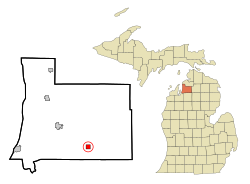Mancelona, Michigan
| Mancelona, Michigan | |
|---|---|
| Village | |
 Location of Mancelona, Michigan |
|
| Coordinates: 44°54′14″N 85°3′38″W / 44.90389°N 85.06056°WCoordinates: 44°54′14″N 85°3′38″W / 44.90389°N 85.06056°W | |
| Country | United States |
| State | Michigan |
| County | Antrim |
| Area | |
| • Total | 1.00 sq mi (2.59 km2) |
| • Land | 1.00 sq mi (2.59 km2) |
| • Water | 0 sq mi (0 km2) |
| Elevation | 1,125 ft (343 m) |
| Population (2010) | |
| • Total | 1,390 |
| • Estimate (2012) | 1,381 |
| • Density | 1,390.0/sq mi (536.7/km2) |
| Time zone | Eastern (EST) (UTC-5) |
| • Summer (DST) | EDT (UTC-4) |
| ZIP code | 49659 |
| Area code(s) | 231 |
| FIPS code | 26-50620 |
| GNIS feature ID | 0631374 |
Mancelona /mænˌsɪˈloʊnə/ is a village in Antrim County in the U.S. state of Michigan. The population was 1,390 at the 2010 census. The village is located within Mancelona Township.
Mancelona Andress, daughter of Perry Andress, was born March 28, 1865 in Missouri. She came to the Mancelona area in 1869, when she was four years old. Her father was the first settler to locate at the site of the town.The township, and later, the village of Mancelona, took its name from her. In 1871 the Township was authorized by the Legislature in Antrim County. People came first primarily to farm. In 1872 the Grand Rapids and Indiana Railroad arrive opening up the Village to southern and northern trade centers. In 1882 a John Otis built a blast furnace in the unincorporated village of Antrim.
Mancelona is probably best known for its annual buck pole, a deer hunting contest that has drawn hunters from across the State. Additionally, Mancelona hosts the annual "Bass Festival", a four-day event featuring a Grand Parade, carnival, flea market, and other community activities. The Bass Festival is held the first weekend in June. In 1999, a new high school was opened, and renovations to the middle school were completed. Up until recently, the town had three factories that employed most of the town. The largest factory, a Dura Automotive Systems plant, closed in February 2009 and the community has had a change for the worse. From 1947 to 1967, Mount Clemens Industries, Incorporated, formerly Mt. Clemens Metal Products Company, used trichloroethylene (TCE) in vapor degreasers. Afterwards, the TCE was disposed of by dumping it on the ground near the building. Some TCE may also have been dumped into seepage pits and burned. Through these improper disposal methods, TCE has now contaminated the groundwater in and around Mancelona, MI. The contaminated plume begins at the manufacturing plant, currently known as Dura Automotive Manufacturing Plant, and extends approximately six miles to the northwest to the Schuss Mountain/Shanty Creek Resort area. The leading edge of the Wickes Manufacturing TCE Plume (also known as Mancelona-Cedar River TCE Plume), at the resort area, is approximately 1.25 miles wide. The plume has also reached the Cedar River, and is now contaminating a cold-water, high quality trout stream. TCE is a colorless liquid with a sweet odor similar to chloroform. TCE is most commonly used as a degreasing solvent in manufacturing plants. Breathing small amounts may cause headaches, dizziness, lung irritation, and difficulty concentrating. Drinking water that contains TCE over an extended period of time can lead to liver and kidney problems and may also be carcinogenic. The TOSC Program at Michigan State University has been asked to provide assistance to Mancelona-area citizens regarding the Mancelona-Cedar River TCE Plume. TOSC met with Antrim County United through Ecology (ACUTE) and Mancelona-area citizens to assess community concerns and discuss TOSC's involvement. TOSC has developed a Memorandum of Understanding, which has been signed jointly by ACUTE and TOSC. While the Mancelona area is as of 2012 the focus of extensive natural gas production activities associated with the Antrim Shale formation, this production does not support employment sufficient to recompense the community for the factories it once had.
...
Wikipedia
